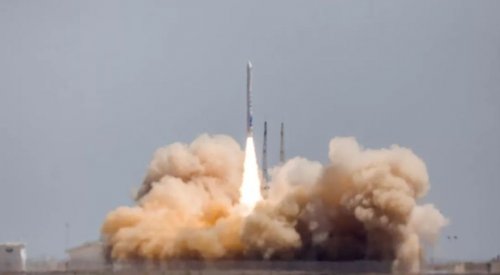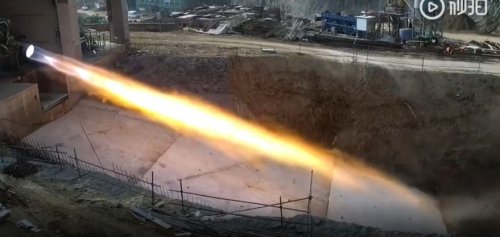HELSINKI — iSpace became the first Chinese private firm to achieve orbit with Thursday’s successful launch from a national space center in the Gobi Desert.
Beijing Interstellar Glory Space Technology Ltd., also known as iSpace, launched the Hyperbola-1 launch vehicle from Jiuquan Satellite Launch Center at 1 a.m. Eastern on July 25.
The test flight carried CAS-7B, an amateur radio satellite, and a technology verification payload for China Central Television, into a 300-kilometer-altitude orbit, with three more small payloads attached to the upper stage.
The success makes iSpace the first Chinese private rocket company to achieve orbit, following failures by Landspace in October and OneSpace in March 27, both of which used solid propellant rockets. The Hyperbola-1 was earlier slated for launch in April, then early June, before slipping for unannounced reasons.
The Hyperbola-1, consisting of three solid stages with a liquid-propellant fourth stage, has a length of 20.8 meters and mass at takeoff of around 31 metric tons.
The buildup to the launch was relatively quiet. The rocket was delivered to Jiuquan in the Gobi Desert July 6, according to a social media video post from Chang’an Automobile Co., Ltd. a Chinese automobile manufacturer, which sponsored the launch through naming the launch vehicle.
iSpace, with a team of over 120 members, is one the leading NewSpace actors in China. It had already received over $100 million in Series A funding from Matrix Partners China, CDH Investments, tech giant Baidu and others, before announcing July 2 that it had secured additional A++ series round funding.
Targeting the light launch market
Chinese NewSpace startups have emerged up following a central government policy shift in late 2014 which opened the launch and small satellite sectors to private capital. Support for the sector has continued, with state and military bodies last month releasing a first set of set of rules and regulations to guide the development of commercial launch vehicles in China.
The speed of the development of launch vehicles by private companies in China has been influenced by a civil-military integration national strategy, facilitating the transfer of restricted technologies to approved firms in order to promote innovation in dual-use technology.
Leena Pivovarova, an analyst at consulting firm Northern Sky Research, told SpaceNews that, China is growing its space program by leaps and bounds, including access to space, including through, “a unified strategy for coordinated public-private efforts to dominate space markets at large.”
“We are seeing accelerated private sector development because of this integration of startups to state-owned defense contractors, who are able to offer pricing well below competition. This is largely possible because of the integrated structure of its industrial base,” Pivovarova says.
The iSpace news release issued after the launch thanked the China Aerospace Science and Technology Corporation (CASC), the giant state-owned space contractor, the defense contractor China Aerospace Science and Industry Corporation, as well as state authority SASTIND, which oversees the space sector, and the Equipment Development Department of the Central Military Commission for their support.
Pivovarova notes however that current regulations restrict China’s customer base, meaning its target market is mainly domestic, in addition to some customers in emerging space countries.
“Long term, China will have to somehow expand into other markets to survive.”
Commercial competition intensifies
While preparations for launch were ongoing at Jiuquan, other Chinese NewSpace claimed progress. All launch vehicles sent to the launchpad by Chinese commercial companies have so far used solid propellant, many of these are working on larger, liquid propellant launchers with reusable first stages.
Landspace, another of the first wave of Chinese private launch companies along with OneSpace and Linkspace, has been making progress with development of liquid methane-liquid oxygen engines for its two-stage Zhuque-2 (Vermillion Bird-2).
In early July Landspace carried out lengthy tests of the TQ-11, a 10-ton thrust methalox engine for the Zhuque-2 second stage. This was followed with a successful 100-second test of the TQ-12 80-ton thrust methalox engine, with a measured sea-level thrust of 667 kN, above the design value of 658 kN.
Four TQ-12 engines will power the first stage of the 48.8-meter-tall, 3.35-meter-diameter Zhuque-2, for which the company says it will hold a test flight in 2020. The launcher is to be capable of delivering a 4,000-kilogram payload capacity to a 200-kilometer low Earth orbit.
A July hot fire test of the TQ-12 methalox engine. Credit: Landspace
iSpace is also working on a methalox launcher, and earlier in July carried out a 200-second test for its JD-1 reusable engine, which will power the first and second stages of the Hyperbola-2 rocket. The launcher will be capable of lifting 1.1 metric tons to a 500 km Sun synchronous orbit (expendable) or 700 kg reusable, with a test flight slated for 2021.
Jiuzhou Yunjian, a Beijing-based 2017 entrant into the Chinese NewSpace launch scene, has also this month tested its newly-developed ‘Lingyun’ 10-ton thrust methalox motor, which the company says demonstrates deep throttling and restart capabilities.
Beijing Xinghe Dongli Space Technology Co. Ltd., also known as Galactic Energy and established in February 2018 — considerably later than the first wave companies — is progressing with development of an RP-1/liquid oxygen launch vehicle named Pallas-1, which will be capable of launching four metric tons to LEO or two tons to SSO. Early July saw testing of the gas generator for the launcher’s 40-tonne thrust kerolox engine, but a test launch is not expected until the end of 2022.
More immediately Galactic Energy is aiming to debut its own solid propellent ‘Ceres-1’ launch vehicle in March 2020, launching from Jiuquan. A main satellite and two passengers are booked for the launch, with the company advertising a remaining 79 kilograms of payload. The company will carry out ground tests across 2019 and aim to complete assembly late in the year.
China Rocket Co. Ltd., a commercial spinoff from CASC, announced July 24 that it was transporting a new, low-cost launcher to Jiuquan, thus providing further competition. The solid propellant Jielong-1 (Smart Dragon-1) is designed to be capable of putting 150 kilograms into a 700-kilometer SSO.
- Q&A | China’s OneSpace ready for first orbital launch attempt
- China’s OneSpace completes rocket assembly ahead of first orbital launch
- Chinese companies OneSpace and iSpace are preparing for first orbital launches
- Chinese startups OneSpace, iSpace succeed with suborbital launches
- Landspace of China to launch first rocket in Q4 2018
Share with your friends


(0) Comments
This article comments are currently no :(